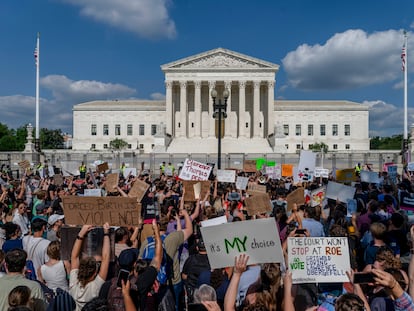Ohio votes on abortion rights this fall. Misinformation about the proposal is already spreading
An effort to guarantee access to abortion rights in Ohio, a November ballot measure, is already fueling misleading claims about how it could influence abortion care, gender-related health care and parental consent in the state

An effort to guarantee access to abortion rights in Ohio, a November ballot measure, is already fueling misleading claims about how it could influence abortion care, gender-related health care and parental consent in the state.
The proposed constitutional amendment would give Ohioans the right to make their own reproductive decisions. Backers say that since Roe v. Wade was overturned last year by the U.S. Supreme Court, the proposal would restore a commonsense abortion protection that most Ohio voters can support.
But opponents argue it would do far more than that. Ads portray the amendment as a gateway to children getting abortions and gender-related surgeries without their parents’ consent. Opponents also have falsely suggested the amendment would open doors to protecting abusers and legalizing infanticide.
The Associated Press spoke to numerous medical and legal experts, who explained what the amendment, known as Issue 1, would mean for Ohioans if it were to pass in November.
The amendment protects Ohio’s right to restrict abortions later in pregnancy
If the amendment passes, Ohio can still restrict abortion beyond the point when a fetus can survive outside the womb. With modern medicine, that point, referred to as the point of viability, is typically about 23 weeks or 24 weeks into the pregnancy.
Yet opponents of the measure argue that the proposal would still allow for abortions “up to birth” because it lets doctors decide when a fetus is viable or not, and because it has an exemption allowing later abortions to protect the life or the health of the mother.
“They could have made it clear. They could have added weeks in there for viability,” said Mehek Cooke, a lawyer working with the opposition campaign, Protect Women Ohio.
Independent medical and legal experts say this argument discounts that doctors have a duty to follow medical science.
The original language from the amendment’s backers defined fetal viability as the fetus having “a significant likelihood of survival outside the uterus with reasonable measures.”
“Obviously, it would be unprofessional for a doctor to say that a 9-month fetus had no possibility of survival outside the uterus unless there was some life-threatening birth defect,” said Dan Kobil, a constitutional law professor at Capital University Law School in Columbus, Ohio. “The rationale offered that physicians have willy-nilly ability to define viability as anything they want is inaccurate.”
Abortions later in pregnancy are exceedingly rare. In 2020, less than 1% of abortions in the United States were performed at or after 21 weeks, according to the federal Centers for Disease Control and Prevention.
“The people who are getting abortions later in pregnancy are those who have incredibly heartbreaking situations, either some awful, terrible fetal anomaly that took a while to be diagnosed or some maternal medical condition that puts the mother’s life at risk,” said Mae Winchester, a Cleveland-based maternal fetal medicine specialist.
Experts say the idea of abortions “up to birth” is misleading in itself. Terminations later in pregnancy involve medication that induces birth early, which is different from a surgical abortion.
“Abortion at the time of birth, it’s literally not a thing,” Sarah Prager, a professor of obstetrics and gynecology at the University of Washington, previously told the AP.
The amendment protects people who assist patients — not people who abuse them
Anti-abortion advocates have argued that the amendment “enables abusers” because it protects any person who “assists” someone in exercising their right to make reproductive decisions.
Ohio Right to Life, an anti-abortion group, reasoned in an online flyer that the amendment could therefore protect an adult man abusing a teenage girl or a teacher going behind a parent’s back.
But legal experts say these arguments would not stand up in court.
“I think that that is an incredibly creative and inaccurate reading of the amendment,” Kobil said. “Abusers do not assist their victims.”
“The idea that an abuser could, by coercing someone to obtain an abortion or to carry a pregnancy to term, somehow be protected or insulated from punishment for that coercion is simply inconsistent with the language of the second provision of the amendment,” he said.
David Cohen, a law professor at Drexel University, said the issue is straightforward. “Abuse is illegal, so abusing someone is illegal under Ohio law,” he said.
Medical experts pointed out that there is some evidence that people seek abortions because they are in abusive relationships. Research has shown that when women in physically abusive relationships are denied abortions, they are more likely to stay with their abuser.
Infanticide is illegal. The amendment doesn’t change that
An analysis of the amendment by the conservative Christian legal group Alliance Defending Freedom claims that it “opens the door to infanticide” because the proposal would block government officials from interfering with someone exercising their right to reproductive freedom.
That analysis questions whether exercising that right includes killing or neglecting a living child.
“Does it include ‘having to care for a newborn baby?’” it says. “Does it include the ‘right’ to neglect or abandon the newborn?”
Numerous legal experts said the answer to those questions is an emphatic no. Infanticide is already illegal in the U.S., they said, and the amendment doesn’t change that.
“That’s just pure nonsense,” Cohen said.
Legal experts say it’s a stretch to claim the amendment is about gender-related health care
Opponents of the abortion amendment say its protection of “reproductive” decisions is unnecessarily broad and could include gender-related health care.
Frank Scaturro, a constitutional lawyer working with Protect Women Ohio, said that under the amendment anything that alters the human reproductive system could be understood as a “reproductive decision.”
Supporters say the proposal makes no mention of gender-related health care — precisely because it’s not about that.
The ballot language specifies that it protects reproductive decisions “including but not limited to” contraception, fertility treatment, continuing one’s own pregnancy, miscarriage care and abortion.
Independent legal experts say it’s a stretch to suggest that also means gender-related health care. That legal theory has not been attempted in other states.
Tracy Thomas, a University of Akron law professor who directs the school’s Center for Constitutional Law, said the term “decision” could be essential in interpreting the language.
“A reproductive decision to me, is a decision to reproduce or not to reproduce,” she said. “The only word there that might arguably be raised (as tied to gender-related care) is fertility treatment. I think fertility treatment is IVF. It means treatment for the purpose of reproducing.”
The amendment doesn’t invalidate parental consent, though that could be challenged in court
The amendment does not change Ohio’s existing parental notification and consent law, which requires minors to have parental permission — or a judicial exception in extreme cases — in order to get an abortion.
That has not stopped the measure’s opponents from arguing that it will be challenged in court, perhaps one day leading to a decision that would make the parental consent law unconstitutional.
Their argument is based on the use of the term “individual” in the amendment, which opponents claim applies to any gender and both adults and children.
Similar arguments related to parental consent were made ahead of Michigan’s vote last year to codify abortion rights in the state’s constitution, said Jessie Hill, a law professor at Case Western Reserve University School of Law who serves as a consultant to the Issue 1 campaign.
“None of these things have come to pass,” Hill said.
To be overturned, Ohio’s existing parental consent law would have to be challenged in court and struck down by the state Supreme Court, which has a conservative majority.
Sign up for our weekly newsletter to get more English-language news coverage from EL PAÍS USA Edition
Tu suscripción se está usando en otro dispositivo
¿Quieres añadir otro usuario a tu suscripción?
Si continúas leyendo en este dispositivo, no se podrá leer en el otro.
FlechaTu suscripción se está usando en otro dispositivo y solo puedes acceder a EL PAÍS desde un dispositivo a la vez.
Si quieres compartir tu cuenta, cambia tu suscripción a la modalidad Premium, así podrás añadir otro usuario. Cada uno accederá con su propia cuenta de email, lo que os permitirá personalizar vuestra experiencia en EL PAÍS.
¿Tienes una suscripción de empresa? Accede aquí para contratar más cuentas.
En el caso de no saber quién está usando tu cuenta, te recomendamos cambiar tu contraseña aquí.
Si decides continuar compartiendo tu cuenta, este mensaje se mostrará en tu dispositivo y en el de la otra persona que está usando tu cuenta de forma indefinida, afectando a tu experiencia de lectura. Puedes consultar aquí los términos y condiciones de la suscripción digital.
More information
Archived In
Últimas noticias
The complicated life of Francesca Albanese: A rising figure in Italy but barred from every bank by Trump’s sanctions
How Japan is trying to avert ‘digital defeat’
Half of Scotland is in the hands of 420 property owners
From digital curfews to blocking apps: How technology experts protect their children online
Most viewed
- Why we lost the habit of sleeping in two segments and how that changed our sense of time
- Trump’s obsession with putting his name on everything is unprecedented in the United States
- Charles Dubouloz, mountaineering star, retires at 36 with a farewell tour inspired by Walter Bonatti
- The Florida Keys tourist paradise is besieged by immigration agents: ‘We’ve never seen anything like this’
- Living in a motorhome due to soaring housing prices in Madrid: ‘I got used to it quickly, but I don’t idealize it’










































